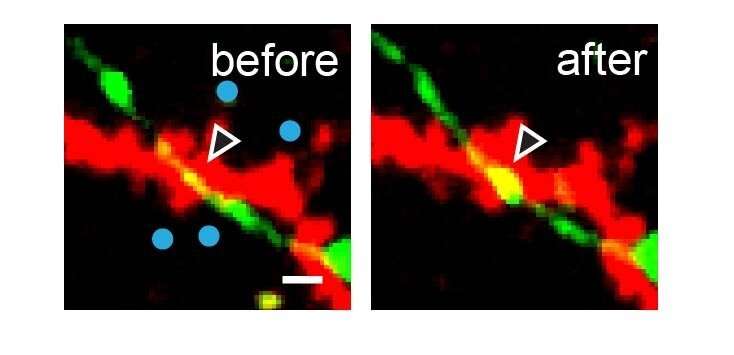Inhibitory synapses grow as 'traffic controller' at busy neural intersections

Neurons pass on information to one another via synapses. The vast majority of these synapses are excitatory, which increase the activity of the receiving neuron. Around 10 to 20 percent of synapses have the opposite effect, and are called inhibitory. Researchers at Utrecht University have discovered that the growth of inhibitory synapses is specifically stimulated in the vicinity of excitatory synapses. The researchers published the results of their research in Cell Reports on 16 April.
Good coordination between excitatory and inhibitory signals is essential for information processing. "Excitatory and inhibitory synapses create a balance in which the inhibitory synapses play a vital role as 'directors' in the brain," explains Corette Wierenga, co-author of the publication. "Together with Hai Yin Hu and Dennis Kruijssen, I've studied what happens when we disrupt that balance in a small area: does the brain restore the balance again? And how is that regulated?
"We activated individual synapses with a technical trick using laser light. That way, we could repeatedly stimulate four excitatory synapses located very near one another on the dendrite of a single specific neuron. The goal was to cause an excess of local activation in order to study whether it was then compensated with additional inhibition. And that was indeed the case—we observed how a new inhibitory synapse started to grow onto that same dendrite."
The researchers discovered that under those conditions, the dendrite secretes a chemical signal that stimulates the formation of an inhibitory synapse. "It's as if a traffic jam suddenly develops at what is normally a quiet intersection: that's where the brain needs a new inhibitory synapse to act as a traffic signal," says Wierenga.
The researchers discovered that the dendrite signals an inhibiting synapse by secreting endocannabinoids. Scientists have long known that neurons produce endocannabinoids – substances that closely resemble the active ingredient in marijuana – but the secretion of these signal chemicals usually results in the weakening of the synapses. "For the first time, we've now proven that endocannabinoids can also stimulate the growth of inhibitory synapses," Wierenga says, "and we've already begun conducting follow-up experiments to study in more detail how that process works."
More information: Hai Yin Hu et al. (2019) Endocannabinoid signaling mediates local dendritic coordination between excitatory and inhibitory synapses. Cell Reports, 16 April 2019. DOI: 10.1016/j.celrep.2019.03.078

















